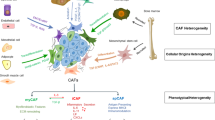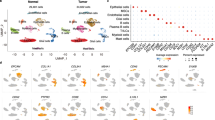Abstract
Epithelial ovarian cancer (EOC) is one of the most common gynecological cancers, with diagnosis often at a late stage. Metastasis is a major cause of death in patients with EOC, but the underlying molecular mechanisms remain obscure. Here, we utilized an integrated approach to find potential key transcription factors involved in ovarian cancer metastasis and identified STAT4 as a critical player in ovarian cancer metastasis. We found that activated STAT4 was overexpressed in epithelial cells of ovarian cancer and STAT4 overexpression was associated with poor outcome of ovarian cancer patients, which promoted metastasis of ovarian cancer in both in vivo and in vitro. Although STAT4 mediated EOC metastasis via inducing epithelial-to-mesenchymal transition (EMT) of ovarian cancer cells in vivo, STAT4 failed to induce EMT directly in vitro, suggesting that STAT4 might mediate EMT process via cancer–stroma interactions. Further functional analysis revealed that STAT4 overexpression induced normal omental fibroblasts and adipose- and bone marrow-derived mesenchymal stem cells to obtain cancer-associated fibroblasts (CAF)-like features via induction of tumor-derived Wnt7a. Reciprocally, increased production of CAF-induced CXCL12, IL6 and VEGFA within tumor microenvironment could enable peritoneal metastasis of ovarian cancer via induction of EMT program. In summary, our study established a model that STAT4 promotes ovarian cancer metastasis via tumor-derived Wnt7a-induced activation of CAFs.
This is a preview of subscription content, access via your institution
Access options
Subscribe to this journal
Receive 50 print issues and online access
$259.00 per year
only $5.18 per issue
Buy this article
- Purchase on Springer Link
- Instant access to full article PDF
Prices may be subject to local taxes which are calculated during checkout










Similar content being viewed by others
References
Nick AM, Coleman RL, Ramirez PT, Sood AK . A framework for a personalized surgical approach to ovarian cancer. Nat Rev Clin Oncol 2015; 12: 239–245.
Kipps E, Tan DS, Kaye SB . Meeting the challenge of ascites in ovarian cancer: new avenues for therapy and research. Nat Rev Cancer 2013; 13: 273–282.
Peng Y, Croce CM . The role of microRNAs in human cancer. Signal Trans Targeted Ther 2016; 1: 1–9.
Yu KH, Snyder M . Omics profiling in precision oncology. Mol Cell Proteomics 2016; 15: 2525–2536.
Liang Y, Pan HF, Ye DQ . Therapeutic potential of STAT4 in autoimmunity. Expert Opin Ther Targets 2014; 18: 945–960.
Cheng JM, Yao MR, Zhu Q, Wu XY, Zhou J, Tan WL et al. Silencing of stat4 gene inhibits cell proliferation and invasion of colorectal cancer cells. J Biol Regul Homeost Agents 2015; 29: 85–92.
Litvinov IV, Cordeiro B, Fredholm S, Odum N, Zargham H, Huang Y et al. Analysis of STAT4 expression in cutaneous T-cell lymphoma (CTCL) patients and patient-derived cell lines. Cell Cycle 2014; 13: 2975–2982.
Wubetu GY, Utsunomiya T, Ishikawa D, Yamada S, Ikemoto T, Morine Y et al. High STAT4 expression is a better prognostic indicator in patients with hepatocellular carcinoma after hepatectomy. Ann Surg Oncol 2014; 21 (Suppl 4): S721–S728.
Hanahan D, Coussens LM . Accessories to the crime: functions of cells recruited to the tumor microenvironment. Cancer Cell 2012; 21: 309–322.
Gandellini P, Andriani F, Merlino G, D'Aiuto F, Roz L, Callari M . Complexity in the tumour microenvironment: cancer associated fibroblast gene expression patterns identify both common and unique features of tumour-stroma crosstalk across cancer types. Semin Cancer Biol 2015; 35: 96–106.
Charlet J, Duymich CE, Lay FD, Mundbjerg K, Dalsgaard Sorensen K, Liang G et al. Bivalent regions of cytosine methylation and H3K27 acetylation suggest an active role for DNA methylation at enhancers. Mol Cell 2016; 62: 422–431.
Shen H, Xu W, Guo R, Rong B, Gu L, Wang Z et al. Suppression of enhancer overactivation by a RACK7-histone demethylase complex. Cell 2016; 165: 331–342.
Ao Z, Shah SH, Machlin LM, Parajuli R, Miller PC, Rawal S et al. Identification of cancer-associated fibroblasts in circulating blood from patients with metastatic breast cancer. Cancer Res 2015; 75: 4681–4687.
Tothill RW, Tinker AV, George J, Brown R, Fox SB, Lade S et al. Novel molecular subtypes of serous and endometrioid ovarian cancer linked to clinical outcome. Clin Cancer Res 2008; 14: 5198–5208.
Ko SY, Barengo N, Ladanyi A, Lee JS, Marini F, Lengyel E et al. HOXA9 promotes ovarian cancer growth by stimulating cancer-associated fibroblasts. J Clin Invest 2012; 122: 3603–3617.
Thibault B, Castells M, Delord JP, Couderc B . Ovarian cancer microenvironment: implications for cancer dissemination and chemoresistance acquisition. Cancer Metastasis Rev 2014; 33: 17–39.
Jeon ES, Moon HJ, Lee MJ, Song HY, Kim YM, Cho M et al. Cancer-derived lysophosphatidic acid stimulates differentiation of human mesenchymal stem cells to myofibroblast-like cells. Stem Cells 2008; 26: 789–797.
McLean K, Gong Y, Choi Y, Deng N, Yang K, Bai S et al. Human ovarian carcinoma-associated mesenchymal stem cells regulate cancer stem cells and tumorigenesis via altered BMP production. J Clin Invest 2011; 121: 3206–3219.
Yoshioka S, King ML, Ran S, Okuda H, MacLean JA 2nd, McAsey ME et al. WNT7A regulates tumor growth and progression in ovarian cancer through the WNT/beta-catenin pathway. Mol Cancer Res 2012; 10: 469–482.
King ML, Lindberg ME, Stodden GR, Okuda H, Ebers SD, Johnson A et al. WNT7A/beta-catenin signaling induces FGF1 and influences sensitivity to niclosamide in ovarian cancer. Oncogene 2015; 34: 3452–3462.
Baumann C, Bonilla WV, Frohlich A, Helmstetter C, Peine M, Hegazy AN et al. T-bet- and STAT4-dependent IL-33 receptor expression directly promotes antiviral Th1 cell responses. Proc Natl Acad Sci USA 2015; 112: 4056–4061.
Zhou X, Xia Y, Su J, Zhang G . Down-regulation of miR-141 induced by helicobacter pylori promotes the invasion of gastric cancer by targeting STAT4. Cell Physiol Biochem 2014; 33: 1003–1012.
Luo Z, Wang Q, Lau WB, Lau B, Xu L, Zhao L et al. Tumor microenvironment: the culprit for ovarian cancer metastasis? Cancer Lett 2016; 377: 174–182.
Chen WJ, Ho CC, Chang YL, Chen HY, Lin CA, Ling TY et al. Cancer-associated fibroblasts regulate the plasticity of lung cancer stemness via paracrine signalling. Nat Commun 2014; 5: 3472.
Thiery JP, Acloque H, Huang RY, Nieto MA . Epithelial-mesenchymal transitions in development and disease. Cell 2009; 139: 871–890.
Lachmann A, Xu H, Krishnan J, Berger SI, Mazloom AR, Ma'ayan A . ChEA: transcription factor regulation inferred from integrating genome-wide ChIP-X experiments. Bioinformatics 2010; 26: 2438–2444.
Roider HG, Manke T, O'Keeffe S, Vingron M, Haas SA . PASTAA: identifying transcription factors associated with sets of co-regulated genes. Bioinformatics 2009; 25: 435–442.
Rhodes DR, Kalyana-Sundaram S, Mahavisno V, Varambally R, Yu J, Briggs BB et al. Oncomine 3.0: genes, pathways, and networks in a collection of 18,000 cancer gene expression profiles. Neoplasia 2007; 9: 166–180.
Zhou S, Yi T, Liu R, Bian C, Qi X, He X et al. Proteomics identification of annexin A2 as a key mediator in the metastasis and proangiogenesis of endometrial cells in human adenomyosis. Mol Cell Proteomics 2012; 11: M112.017988.
Kenny HA, Krausz T, Yamada SD, Lengyel E . Use of a novel 3D culture model to elucidate the role of mesothelial cells, fibroblasts and extra-cellular matrices on adhesion and invasion of ovarian cancer cells to the omentum. Int J Cancer 2007; 121: 1463–1472.
Sharon Y, Alon L, Glanz S, Servais C, Erez N . Isolation of normal and cancer-associated fibroblasts from fresh tissues by fluorescence activated cell sorting (FACS). J Vis Exp 2013; 71: e4425.
Tang L, Chen Y, Pei F, Zhang H . Lithium chloride modulates adipogenesis and osteogenesis of human bone marrow-derived mesenchymal stem cells. Cell Physiol Biochem 2015; 37: 143–152.
Kim KW, Moon SJ, Park MJ, Kim BM, Kim EK, Lee SH et al. Optimization of adipose tissue-derived mesenchymal stem cells by rapamycin in a murine model of acute graft-versus-host disease. Stem Cell Res Ther 2015; 6: 202.
Cordero AB, Kwon Y, Hua X, Godwin AK . In vivo imaging and therapeutic treatments in an orthotopic mouse model of ovarian cancer. J Vis Exp 2010; 42: 2125.
Xu X, Ayub B, Liu Z, Serna VA, Qiang W, Liu Y et al. Anti-miR182 reduces ovarian cancer burden, invasion, and metastasis: an in vivo study in orthotopic xenografts of nude mice. Mol Cancer Ther 2014; 13: 1729–1739.
Acknowledgements
This work was supported by grants from the National Natural Science Foundation of China (grant #81402396), Sichuan Science-Technology Soft Sciences Project (grant #2016ZR0086), Yi Yao Foundation (grant #14H0563) and Direct Scientific Research Grants from West China Second Hospital, Sichuan University (grant #KS021).
Author information
Authors and Affiliations
Corresponding author
Ethics declarations
Competing interests
The authors declare no conflict of interest.
Additional information
Supplementary Information accompanies this paper on the Oncogene website
Supplementary information
Rights and permissions
About this article
Cite this article
Zhao, L., Ji, G., Le, X. et al. An integrated analysis identifies STAT4 as a key regulator of ovarian cancer metastasis. Oncogene 36, 3384–3396 (2017). https://doi.org/10.1038/onc.2016.487
Received:
Revised:
Accepted:
Published:
Issue Date:
DOI: https://doi.org/10.1038/onc.2016.487
This article is cited by
-
The role of stromal cells in epithelial–mesenchymal plasticity and its therapeutic potential
Discover Oncology (2024)
-
Development of a necroptosis-related gene signature and the immune landscape in ovarian cancer
Journal of Ovarian Research (2023)
-
The metastatic capacity of high-grade serous ovarian cancer cells changes along disease progression: inhibition by mifepristone
Cancer Cell International (2022)
-
A comprehensive analysis of somatic alterations in Chinese ovarian cancer patients
Scientific Reports (2021)
-
JAK2 regulates paclitaxel resistance in triple negative breast cancers
Journal of Molecular Medicine (2021)



